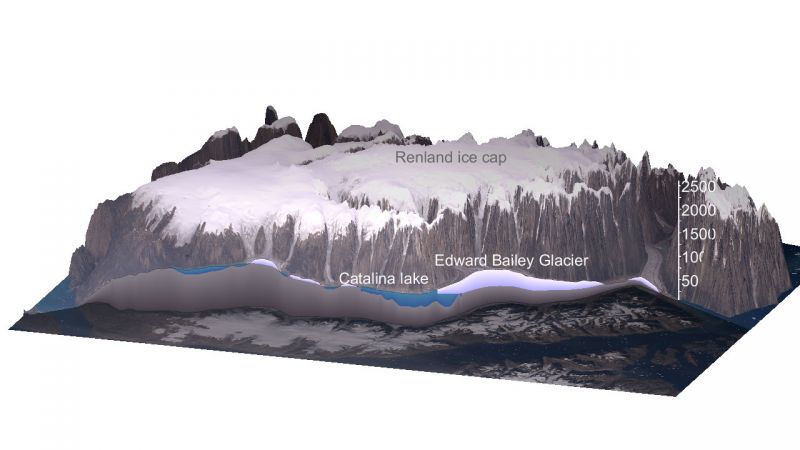Satellite Photos Reveal Gigantic Outburst Floods
Published on by Water Network Research, Official research team of The Water Network in Academic
Researchers from Niels Bohr Institute, University of Copenhagen, Denmark, studied satellite photographs of Lake Catalina, an ice-dammed lake in East Greenland – and were truly amazed.
Unnoticed by science as well as people living in the area, the lake has been the source of four major outburst floods over the last 50 years - each representing an astounding mass of energy, equaling up to 240 Hiroshima-bombs! ”The next outburst is certainly building and may happen as soon as 2018-19”, says Aslak Grinsted, head of the research team.

Lake Catalina receives melt water from Renlands ice cap. The top of the ice cap is 2.500 meter above sea level. The melting – and the filling up of Lake Catalina – takes place during the summer. When the water reaches a certain level in Lake Catalina, Edward Bailey Glacier can no longer hold it back – and an outburst flood is a reality. Illustration: Aslak Grinsted.
If a glacier keeping back an ice-dammed lake starts leaking, the end result may be emission of almost unfathomable quantities of water in the form of an outburst flood.
For the last 200 years science has recorded a considerable number of outburst floods from ice-dammed lakes in mountainous regions all over the globe from Norway to USA, Iceland, Kyrgyzstan, Canada, Austria and Switzerland. In most cases it has been known in advance that an outburst was under way, prompting some state of alert in order to avoid loss of lives.
However, some of the biggest outburst floods ever recorded have remained unknown until recently.
These outbursts - a total of four taking place between 1966 and 2012 - originate from Lake Catalina, an ice-dammed lake on Renland, a 100 kilometer long island in Scoresbysund Fjord in East Greenland, located about 180 kilometer west of Scoresbysund settlement (Ittoqqortoormiit). And each of these outbursts has released in the order of 2.6-3.4 cubic kilometer of fresh water!
3.4 cubic kilometer of water is somewhat more than a shower – it equals 3.400 billion liter. Which, according to scientific reports covering the period from 1818 till present, has catapulted Lake Catalina into the top-5 rankings on the all-time-great-chart of registered outburst floods coming from ice-dammed lakes; surpassed only by outbursts in Argentina and USA with a thumping one - 5.400 billion liter from Hubbard Glacier in Alaska in 1986 - as the undisputed record holder.
All details regarding the Greenlandic mega outbursts will ‘go public’ via an article appearing in the upcoming issue of Scientific Reports.
The article is written by Dorte Dahl-Jensen, Christine Hvidberg and Aslak Grinsted - the three researchers from Centre for Ice and Climate at the Niels Bohr Institute who made the discovery – and Néstor Campos of Complutense University, Madrid, Spain, who assisted the Danish team in describing the phenomenon.
By analyzing data from the photographs the scientists were able to construct a model which – with some certainty – can predict when the next outburst flood from the lake can be expected to take place, explains Aslak Grinsted: “It is certainly building right now, and according to the model it will happen at the latest in 2023. However, it may occur as soon as next year, in the winter of 2018-19”.
The uncertainty surrounding the advent of the next mega outburst from Catalina Lake can be attributed to the rising temperatures experienced in Greenland and in the arctic regions these years due to global warming – increasing the melt down of glaciers and thereby making barriers keeping water ‘inboard’ in ice-dammed lakes leaking sooner than expected, explains Aslak Grinsted.
Read full article: Niels Bohr Institute
Media
Taxonomy
- Geology
- Remote Sensing & Data Analysis
- Hydrogeology
- Flood Modeling
- Flood prediction
- Remote Monitoring & Control
- GIS & Remote Sensing